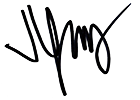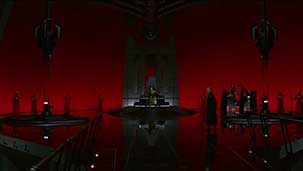There’s something wonderfully analog about the latest Star Wars film, The Last Jedi. Something gratingly modern about it, too, but the eight-year-old inside me compels me to focus on the positives first (and perhaps ignore the negatives altogether).
Much of this retro vibe comes through in the design of the film. The sets, costumes, props. All the stuff your hard work enabled (your CV is so wonderfully diverse it’s hard to guess what exactly you might have been assisting with). If there is a single image in this film that feels foundational to me, it’s those lovely wide shots of Supreme Leader Snoke’s chamber aboard the gigantic dreadnought spaceship. At first glance, it looks like the studio setting for an early-80s music video. Flat red backdrops, vignetted, glowing with light. Standing all around are guards in glossy red samurai armour. Snoke’s throne sits atop a sort of raised hexagon, and he appears to be wearing something that David Bowie left behind when he transcended to the Nth dimension. It all feels both utterly new and completely of the world that has been established over the course of the last eight Star Wars films (yes, even those ones). It’s something straight out of ’70s sci-fi—Logan’s Run or Silent Running or, yes, even Zardoz. It looks cheap. But in the best possible way. The broad, glossy floors are imperfect; we can see scuffs, lines, motes of dust. The helmets worn by the security guards on the casino planet (yes, the franchise borrows a page from its rival Star Trek and introduces us to a casino planet) display huge digital numbers and seem, in their matte flatness and simplicity, like something that might be drawn by a pre-teen fan. It’s all real in a way that so few contemporary blockbusters are, with their endlessly fiddled-with pixels. This sense of realness is what has always made the best parts of Star Wars the best parts: the practical effects, the weight of everything (look no further than the 1997 special editions to see how timeless those old models and masks look compared to computer VFX).
The plot spins and whirls around these images. Like the other middle act, Empire Strikes Back, this film is strangely structured. It betrays expectations because there is no way to expect it. A and B and C plots interweave and collide (not all of them successfully). There are mutinies and betrayals and flashbacks and non-sequiturs and all sorts of other common storytelling elements that nonetheless feel completely new to the Star Wars series. The story ebbs and flows. It pretends to take us to unexpected places, and then doesn’t, but then again, could it really? This is a generational myth, after all. There is no branch of Judeo-Christianity in which Jesus switches sides, becomes a Buddhist, moves to a sustainable farm in Northern California, gets married and divorced, opens an artisanal cheese shop. Some religious narratives can only be bent, not broken.
And the negatives? Well, I’m going listen to my inner eight-year-old and brush them off. They’re common, after all. The same things that plague every big movie these days; an exhausting plentitude meant to justify a twenty-dollar ticket price (perhaps the real magic of The Force Awakens was its seeming leanness). But if I am ever going to forgive a movie for being overstuffed, it will be a Star Wars movie, and so, here it is, my meaningless five-star rating. Why? Because Star Wars, that’s why.
Sincerely,

Jared







